Posted: 2024-02-25
AlmaLinux 9 can be configured to provide remote access to the graphical desktop environment over a network or internet connection. Although not enabled by default, displaying and accessing an AlmaLinux 9 desktop from a system anywhere else on a network or the internet is relatively straightforward. This can be achieved regardless of whether that system runs Linux, Windows, or macOS. There are even apps available for Android and iOS that will allow you to access your AlmaLinux 9 desktop from just about anywhere that a data signal is available.
Remote desktop access can be helpful in many scenarios. For example, it enables you or another person to view and interact with your AlmaLinux 9 desktop environment from another computer system on the same network or over the internet. This is useful if you need to work on your computer when you are away from your desk, such as while traveling. It is also helpful when a coworker or IT support technician needs access to your desktop to resolve a problem.
When the AlmaLinux 9 system runs on a cloud-based server, it also allows access to the desktop environment as an alternative to performing administrative tasks using the command-line prompt or Cockpit web console.
The AlmaLinux 9 remote desktop functionality is based on a technology known as Virtual Network Computing (VNC). This chapter will cover the key aspects of configuring and using remote desktops within AlmaLinux 9.
 |
You are reading a sample chapter from AlmaLinux 9 Essentials. Buy the full book now in eBook format.
Full book includes 34 chapters and 290 pages. Learn more. |
Secure and Insecure Remote Desktop Access
In this chapter, we will cover both secure and insecure remote desktop access methods. Assuming you are accessing one system from another within a secure internal network, using the insecure access method is generally safe. If, on the other hand, you plan to access your desktop remotely over any public network, you must use the secure method of access to avoid your system and data being compromised.
Installing the GNOME Desktop Environment
It is, of course, only possible to access the desktop environment if the desktop itself has been installed. If, for example, the system was initially configured as a server, it is unlikely that the desktop packages were installed. The easiest way to install the packages necessary to run the GNOME desktop is to perform a group install. The key to installing groups of packages to enable a specific feature is knowing the group’s name. At the time of writing, there are two groups for installing the desktop environment on AlmaLinux 9: “Server with GUI” and “Workstation”. As the group names tend to change from one AlmaLinux release to another, it is helpful to know that the list of groups that are either installed or available to be installed can be obtained using the dnf utility as follows:
# dnf grouplist
Available Environment Groups:
Server
Minimal Install
Workstation
Virtualization Host
Custom Operating System
Installed Environment Groups:
Server with GUI
Installed Groups:
Container Management
Headless Management
Available Groups:
RPM Development Tools
.NET Development
Console Internet Tools
Scientific Support
Legacy UNIX Compatibility
Graphical Administration Tools
Network Servers
System Tools
Development Tools
Security Tools
Smart Card Support
Code language: plaintext (plaintext)The Workstation environment group is listed as available (and therefore not already installed) in the above example. To find out more information about the contents of a group before installation, use the following command:
# dnf groupinfo workstation
Environment Group: Workstation
Description: Workstation is a user-friendly desktop system for laptops and PCs.
Mandatory Groups:
Common NetworkManager submodules
Core
Fonts
GNOME
Guest Desktop Agents
Hardware Support
Internet Browser
Multimedia
Printing Client
Standard
Workstation product core
base-x
Optional Groups:
Backup Client
GNOME Applications
Headless Management
Internet Applications
Office Suite and Productivity
Remote Desktop Clients
Smart Card Support
Code language: plaintext (plaintext)Having confirmed that this is the correct group, it can be installed as follows:
# dnf groupinstall workstationCode language: plaintext (plaintext)Once installed, and assuming that the system has a display added, the desktop can be launched using the following startx command:
 |
You are reading a sample chapter from AlmaLinux 9 Essentials. Buy the full book now in eBook format.
Full book includes 34 chapters and 290 pages. Learn more. |
$ startxCode language: plaintext (plaintext)To launch the graphical desktop each time the system starts, change the default target as follows:
# systemctl set-default graphical.targetCode language: plaintext (plaintext)If, on the other hand, the system is a server with no directly connected display, the only way to run and access the desktop will be to configure VNC support on the system.
Installing VNC on AlmaLinux 9
Access to a remote desktop requires a VNC server installed on the remote system, a VNC viewer on the system from which access is being established, and, optionally, a secure SSH connection. While several VNC server and viewer implementations are available, Red Hat has standardized on TigerVNC, which provides both server and viewer components for Linux-based operating systems. VNC viewer clients for non-Linux platforms include RealVNC and TightVNC. To install the TigerVNC server package on AlmaLinux 9, run the following command:
# dnf install tigervnc-serverCode language: plaintext (plaintext)If required, the TigerVNC viewer may also be installed as follows:
# dnf install tigervncCode language: plaintext (plaintext)Once the server has been installed, the system must be configured to run one or more VNC services and open the appropriate ports on the firewall.
 |
You are reading a sample chapter from AlmaLinux 9 Essentials. Buy the full book now in eBook format.
Full book includes 34 chapters and 290 pages. Learn more. |
Assigning Ports to Users
VNC uses a range of ports starting at 5900 to communicate with remote clients. When connecting to a VNC server, these ports are referenced as display numbers (where 5901 is display :1, 5902 is display :2, and so on).
When setting up VNC on AlmaLinux 9, it is helpful to assign a specific port to each remote user to provide consistency in gaining access. Port assignments are declared in the /etc/tigervnc/vncserver. users file and use the following format:
display_number=userCode language: plaintext (plaintext)It is recommended that port assignments begin at 5902. For example, the following entry in the vncserver.users file assigns display :2 (port 5902) to user demo:
:2=demoCode language: plaintext (plaintext)Configuring the VNC Server
With the VNC server packages installed, the next step is configuring the server. System-wide settings may be declared within the /etc/tigervnc/vncserver-config-defaults file, while settings for individual users can be placed in the $HOME/.vnc/config file. At a minimum, one of these files should contain the following entry:
session=gnomeCode language: plaintext (plaintext)Setting up a VNC Password
The next step is to specify a password for the remote desktop environment user. While logged in as the remote user, execute the vncpasswd command as follows:
 |
You are reading a sample chapter from AlmaLinux 9 Essentials. Buy the full book now in eBook format.
Full book includes 34 chapters and 290 pages. Learn more. |
[demo@demoserver ~]$ vncpasswd
Password:
Verify:
Would you like to enter a view-only password (y/n)? n
A view-only password is not usedCode language: plaintext (plaintext)Next, the firewall needs to be configured to provide external access to the VNC server for remote VNC viewer instances, for example:
# firewall-cmd --permanent --add-service=vnc-server
# firewall-cmd --reloadCode language: plaintext (plaintext)Starting VNC Server
With the service configuration file created, the service needs to be started as follows (where <number> is replaced by the VNC display number:
systemctl start vncserver@<number>Code language: plaintext (plaintext)The following command, for example, starts the VNC server for display :2:
# systemctl start vncserver@:2Code language: plaintext (plaintext)Check that the service has started successfully as follows:
# systemctl status vncserver@:2
● vncserver@:2.service - Remote desktop service (VNC)
Loaded: loaded (/usr/lib/systemd/system/[email protected]; enabled; prese>
Active: active (running) since Thu 2023-08-24 15:50:07 CDT; 21h ago
Process: 1027 ExecStartPre=/usr/libexec/vncsession-restore :2 (code=exited,>
Process: 1107 ExecStart=/usr/libexec/vncsession-start :2 (code=exited, stat>
Main PID: 1114 (vncsession)
Tasks: 0 (limit: 22131)
Memory: 1.9M
CPU: 38ms
CGroup: /system.slice/system-vncserver.slice/vncserver@:2.service
1114 /usr/sbin/vncsession demo :2Code language: plaintext (plaintext)If the service fails to start, run the journalctl command to check for error messages:
 |
You are reading a sample chapter from AlmaLinux 9 Essentials. Buy the full book now in eBook format.
Full book includes 34 chapters and 290 pages. Learn more. |
# journalctl -xeCode language: plaintext (plaintext)Also, try again after rebooting the system before tying again. If the problem persists, check the VNC log file located in the user’s $HOME/.vnc directory for diagnostic messages.
Connecting to a VNC Server
VNC viewer implementations are available for a wide range of operating systems. Therefore, a quick internet search will likely provide numerous links containing details on obtaining and installing this tool on your chosen platform.
First, verify that the remote user has logged out of all local desktop sessions (the VNC server will not start if the user has an active desktop session).
From the desktop of a Linux system on which a VNC viewer such as TigerVNC is installed, a remote desktop connection can be established as follows from a Terminal window:
$ vncviewer <hostname>:<display number>Code language: plaintext (plaintext)In the above example, <hostname> is either the hostname or IP address of the remote system and <display number> is the display number of the VNC server desktop, for example:
 |
You are reading a sample chapter from AlmaLinux 9 Essentials. Buy the full book now in eBook format.
Full book includes 34 chapters and 290 pages. Learn more. |
$ vncviewer 192.168.86.34:2Code language: plaintext (plaintext)Alternatively, run the command without any options to be prompted for the details of the remote server:
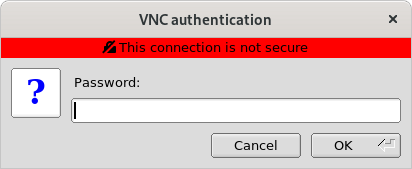
Enter the hostname or IP address followed by the display number (for example, 192.168.86.34:2) into the VNC server field and click on the Connect button. The viewer will prompt for the user’s VNC password to complete the connection, at which point a new window containing the remote desktop will appear:
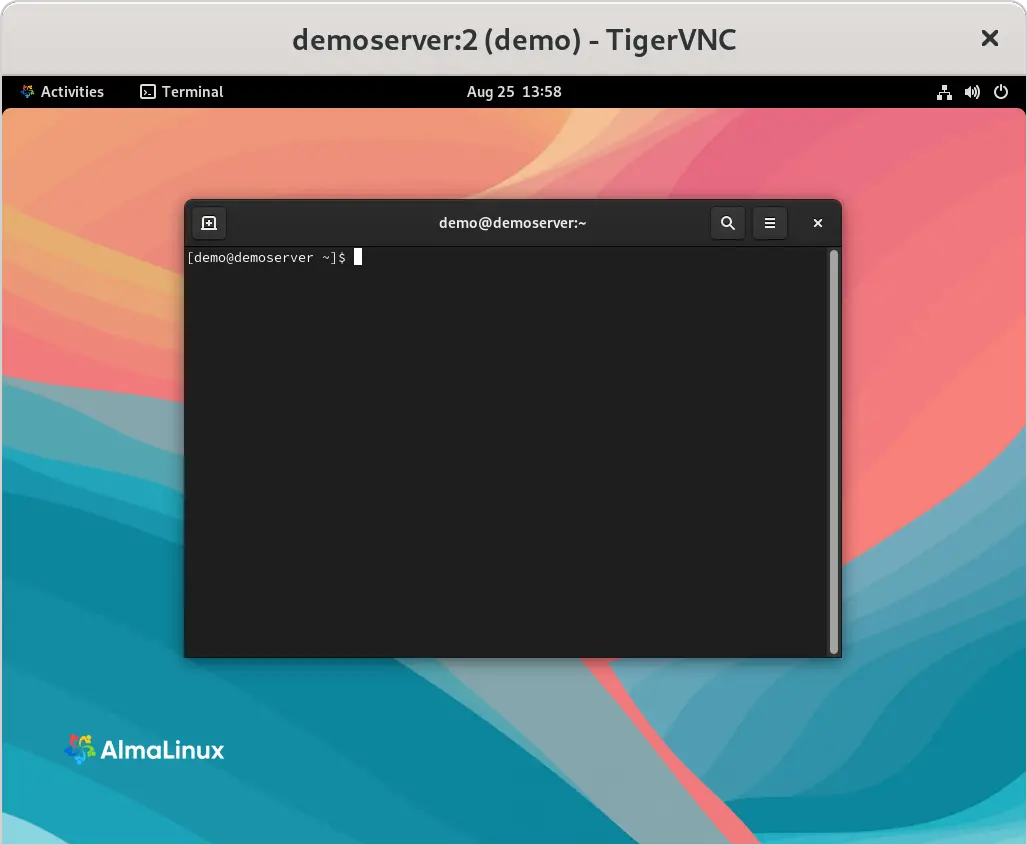
This section assumed that the remote desktop was accessed from a Linux or UNIX system; the same steps apply to most other operating systems.
Connecting to a remote VNC server using the steps in this section results in an insecure, unencrypted connection between the client and server. This means the data transmitted during the remote session is vulnerable to interception. Therefore, a few extra steps are necessary to establish a secure and encrypted connection.
Establishing a Secure Remote Desktop Session
The remote desktop configurations explored in this chapter are considered insecure because no encryption is used. This is acceptable when the remote connection does not extend outside an internal network protected by a firewall. However, a more secure option is needed when a remote session is required over an internet connection. This is achieved by tunneling the remote desktop through a secure shell (SSH) connection. This section will cover how to do this on Linux, UNIX, and macOS client systems.
 |
You are reading a sample chapter from AlmaLinux 9 Essentials. Buy the full book now in eBook format.
Full book includes 34 chapters and 290 pages. Learn more. |
The SSH server is typically installed and activated by default on AlmaLinux 9 systems. If this is not the case on your system, refer to the chapter Configuring SSH Key-based Authentication on AlmaLinux 9.
Assuming the SSH server is installed and active, it is time to move to the other system. At the other system, log in to the remote system using the following command, which will establish the secure tunnel between the two systems:
$ ssh -l <username> -L 5902:localhost:5902 <remotehost>Code language: plaintext (plaintext)In the above example, <username> references the user account on the remote system for which VNC access has been configured, and <remotehost> is either the hostname or IP address of the remote system, for example:
$ ssh -l neilsmyth -L 5902:localhost:5902 192.168.1.115Code language: plaintext (plaintext)When prompted, log in using the account password. With the secure connection established, it is time to launch vncviewer to use the secure tunnel. Leaving the SSH session running in the other terminal window, launch another terminal and enter the following command:
$ vncviewer localhost:5902Code language: plaintext (plaintext)The vncviewer session will prompt for a password if one is required, and then launch the VNC viewer providing secure access to your desktop environment.
 |
You are reading a sample chapter from AlmaLinux 9 Essentials. Buy the full book now in eBook format.
Full book includes 34 chapters and 290 pages. Learn more. |
Although the connection is now secure and encrypted, the VNC viewer will most likely still report that the connection is insecure. Figure 16-3, for example, shows the warning dialog displayed by the RealVNC viewer running on a macOS system:
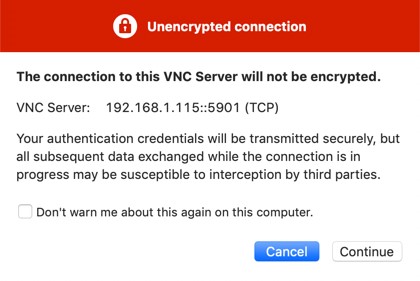
Unfortunately, although the connection is now secure, the VNC viewer software has no way of knowing this and consequently continues to issue warnings. However, rest assured that as long as the SSH tunnel is being used, the connection is indeed secure.
In the above example, we left the SSH tunnel session running in a terminal window. If you would prefer to run the session in the background, this can be achieved by using the –f and –N flags when initiating the connection:
$ ssh -l <username> -f -N -L 5902:localhost:5902 <remotehost>Code language: plaintext (plaintext)The above command will prompt for a password for the remote server and then establish the connection in the background, leaving the terminal window available for other tasks.
If you are connecting to the remote desktop from outside the firewall, keep in mind that the IP address for the SSH connection will be the external IP address provided by your ISP or cloud hosting provider, not the LAN IP address of the remote system (since this IP address is not visible to those outside the firewall). Therefore, you will also need to configure your firewall to forward port 22 (for the SSH connection) to the IP address of the system running the desktop. It is not necessary to forward port 5900. Steps to perform port forwarding differ between firewalls, so refer to the documentation for your firewall, router, or wireless base station for details specific to your configuration.
 |
You are reading a sample chapter from AlmaLinux 9 Essentials. Buy the full book now in eBook format.
Full book includes 34 chapters and 290 pages. Learn more. |
Establishing a Secure Tunnel on Windows using PuTTY
A similar approach is taken to establishing a secure desktop session from a Windows system to an AlmaLinux 9 server. Assuming you already have a VNC client such as TightVNC installed, the remaining requirement is a Windows SSH client (in this case, PuTTY).
Once PuTTY is downloaded and installed, the first step is establishing a secure connection between the Windows system and the remote AlmaLinux 9 system with appropriate tunneling configured. When launched, PuTTY displays the following screen:
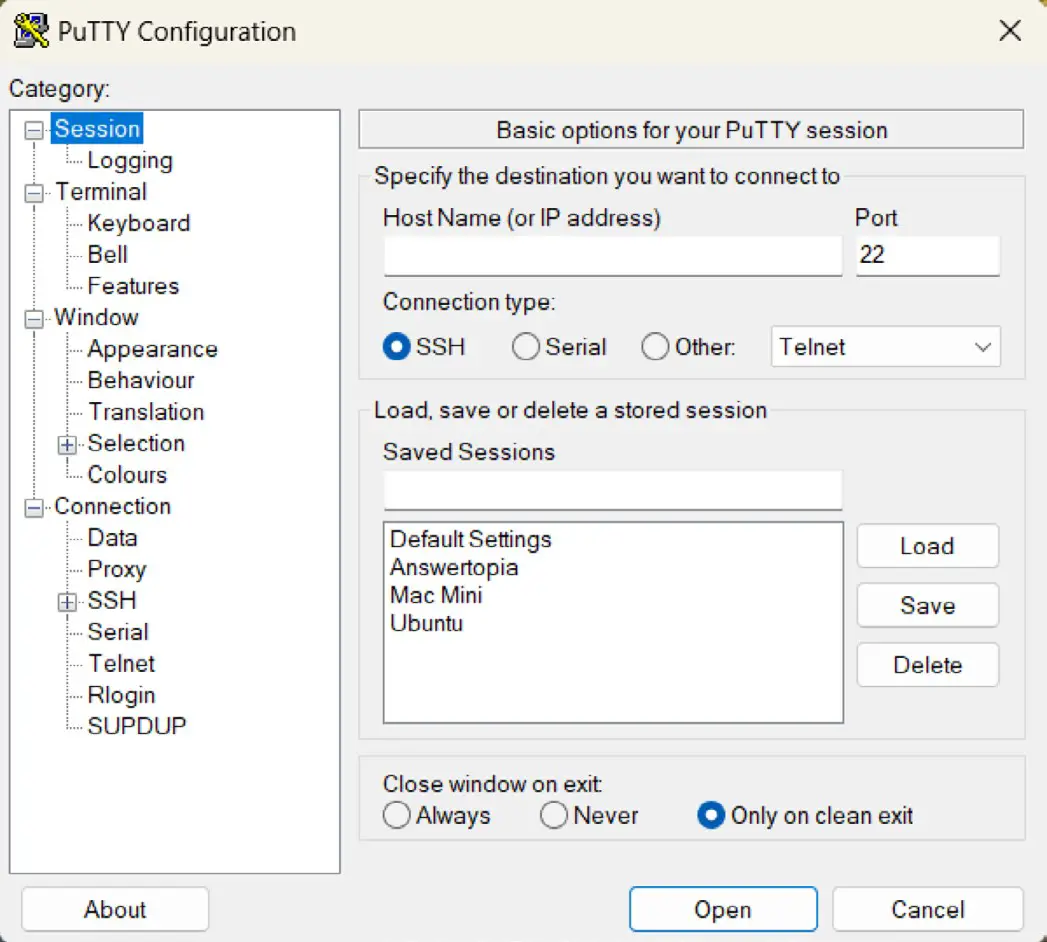
Enter the IP address or hostname of the remote host (or the external IP address of the gateway if you are connecting from outside the firewall). The next step is to set up the tunnel. Click on the + next to SSH in the Category tree on the left-hand side of the dialog and select Tunnels. The screen should subsequently appear as follows:
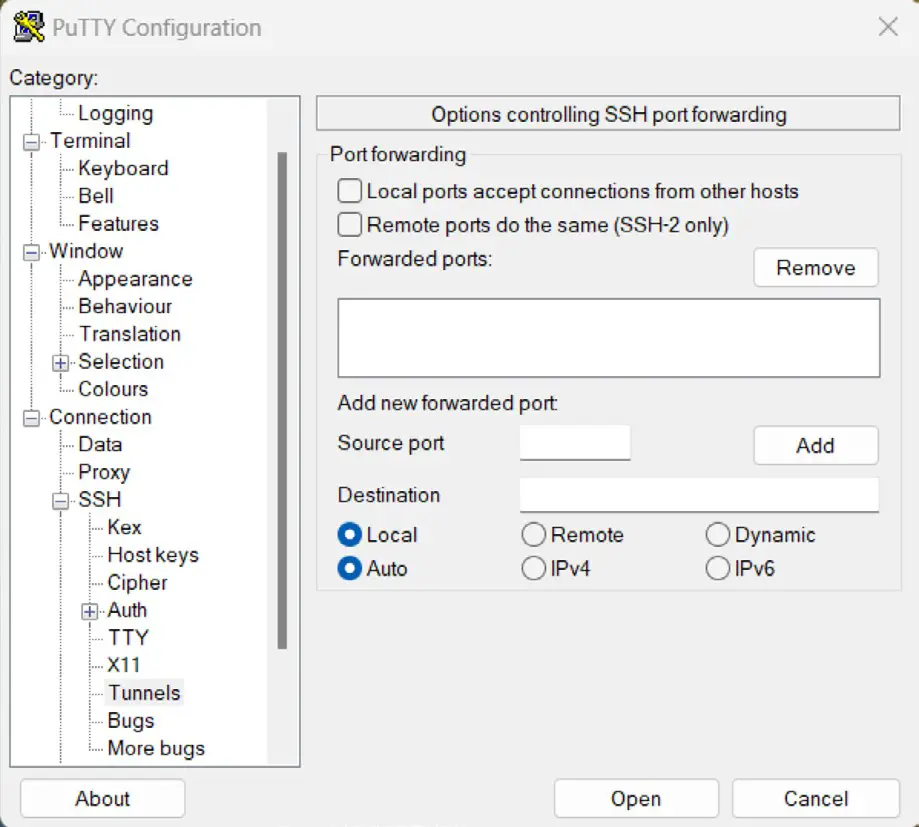
Enter 5901 as the Source port and localhost:5901 as the Destination, and click the Add button. Finally, return to the main screen by clicking on the Session category. Enter a name for the session in the Saved Sessions text field and press Save. Click on Open to establish the connection. A terminal window will appear with the login prompt from the remote system. Enter the appropriate user login and password credentials.
The SSH connection is now established. Launch the TightVNC viewer, enter localhost:5901 in the VNC Server text field, and click Connect. The viewer will establish the connection, prompt for the password, and then display the desktop. You are now accessing the remote desktop of a Linux system from Windows over a secure SSH tunnel connection.
 |
You are reading a sample chapter from AlmaLinux 9 Essentials. Buy the full book now in eBook format.
Full book includes 34 chapters and 290 pages. Learn more. |
Shutting Down a Desktop Session
To shut down a VNC server-hosted desktop session, use the systemctl stop command. For example, to stop desktop :2:
# systemctl stop vncserver@:2Code language: plaintext (plaintext)The VNC server must be stopped before the user attempts to log into a local desktop session. If the user’s VNC server is still running, the local desktop session will appear as a blank screen.
Summary
Remote access to the GNOME desktop environment of an AlmaLinux 9 system can be enabled by using Virtual Network Computing (VNC). Comprising the VNC server running on the remote server and a corresponding client on the local host, VNC allows remote access to multiple desktop instances running on the server.
When the VNC connection is being used over a public connection, SSH tunneling is recommended to ensure that the communication between the client and server is encrypted and secure.
